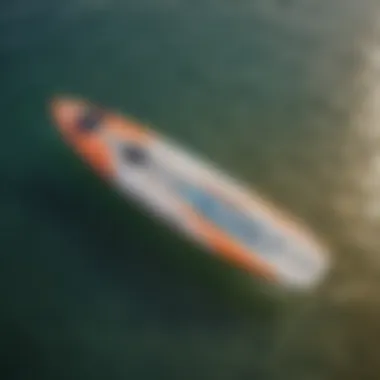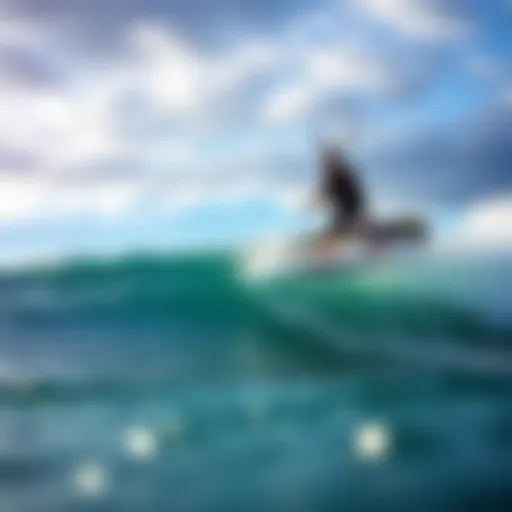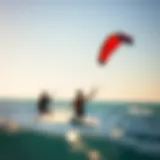Exploring the Armstrong Wing Sup Foilboard: A Guide


Intro
When it comes to kiteboarding, having the right equipment can make or break your experience on the water. Among the various options available, the Armstrong Wing Sup Foilboard stands out with its innovative design and functionality. In this guide, we’ll explore everything relevant to understand this foilboard better, from its technical specifications to practical riding techniques. Riders can often feel overwhelmed when faced with various gear options, so this comprehensive examination will hopefully serve as a valuable resource.
We’ll break down key features and benefits that the Armstrong Wing Sup Foilboard offers, looking closely at the technology that makes it a superb choice for both newcomers and seasoned kiteboarders alike. Additionally, we’ll delve into crucial tips and techniques aimed at enhancing your skills. Finally, synthesizing all this information will empower you to make informed choices about your next kiteboarding adventure.
Gear Insights
Latest Gear Reviews
If you’re on the lookout for top-notch gear, the Armstrong Wing Sup Foilboard has garnered attention for its exceptional performance on different water conditions. One of the standout features is its durable construction, which balances weight and stability effectively. Many enthusiasts rave about the board's responsiveness, especially when making quick turns or adjustments while riding. For instance, the foot strap system is adjustable, enabling a customized fit that enhances comfort during long sessions.
The foil’s design plays a crucial role in its performance. Many riders appreciate how effortlessly it glides through the water. This efficiency not only improves speed but also helps reduce fatigue and increase overall ride time.
Essential Gear for Beginners
For those just beginning their kiteboarding journey, having the right gear is essential for a smooth learning curve. Apart from the Armstrong Wing Sup Foilboard itself, consider these essentials:
- Kite: Opt for a size that aligns with your skill level and local wind conditions.
- Harness: A waist or seat harness provides comfort and allows for optimal control while riding.
- Safety Leash: This is a vital piece of equipment that keeps you connected to your kite in case of an accidental release.
Getting acquainted with your gear, and how it interacts with the foilboard, can significantly improve your performance on the water.
Techniques and Tips
Advanced Tricks and Techniques
Once you've gained confidence, it might be time to explore advanced maneuvers. Tricks like the downloop transition and air jibe are a couple of crowd-pleasers that require finesse and practice.
Here are some tips to master these tricks:
- Practice in calm water to gain confidence in your balance and control before attempting high-speed maneuvers.
- Focus on kite control; maintaining consistent tension in your lines is key.
- Use your body to shift weight significantly; this will help in making smoother turns.
Safety Practices for Kiteboarders
Safety on the water is paramount. Here are some effective practices:
- Always check your gear before a session to catch any potential issues.
- Keep an eye on weather conditions; sudden changes can lead to dangerous situations.
- Always ride within your skill level and never hesitate to ask for help or guidance from more experienced riders.
"Knowledge and preparation often make the difference between enjoyment and a frustrating experience on the water."
By embracing safety measures and honing your techniques, you can make the most of your time with the Armstrong Wing Sup Foilboard.
This comprehensive guide provides you with the insights needed to navigate the exciting world of kiteboarding while maximizing the benefits of your gear.
Prelims to Foilboarding
Foilboarding, an increasingly popular water sport, brings together elements of traditional surfing and cutting-edge hydrofoil technology. As riders take to the water, the sensation of gliding above it is nothing short of exhilarating. This unique blend of surfing and flying really captures the spirit of adventure, appealing to kiteboarders, instructors, travelers, adventurers, and hobbyists alike. In this section, we will dive into the core aspects of foilboarding, emphasizing its importance in the context of our exploration of the Armstrong Wing Sup Foilboard.
What is Foilboarding?
At its essence, foilboarding involves riding a board elevated above the water by a hydrofoil—a specialized fin that projects below the surface. This foil displaces water, generating lift as the rider gains speed. The sensation is akin to flying, stirring excitement and a strong sense of freedom. The experience transcends ride-specific feelings, enabling riders to embrace the environment around them.
Benefits of foilboarding include:
- Enhanced Speed: Thanks to the reduced drag, riders find they can reach impressive speeds, even in relatively light winds.
- Smooth Ride: The hydrofoil minimizes the impact of waves, providing a smoother experience compared to traditional surfing.
- Accessibility: It can be enjoyed in a variety of water conditions, making it suitable for a wide range of locations and climates.
The Evolution of Foilboarding
Foilboarding has evolved significantly since its inception. Initially seen as a niche pursuit, the sport has expanded rapidly, catching the attention of water sport enthusiasts around the globe. In the early days, hydrofoils were simply experimental, often clunky designs that made the activity more cumbersome than enjoyable. However, as technology advanced, manufacturers began producing more sophisticated models that allowed for improved performance and maneuverability.
Key milestones in the development of foilboarding include:
- Innovation in Materials: The evolution from heavy, rigid materials to lightweight composites has drastically affected performance.
- Design Refinements: Advances in hydrodynamics led to the creation of more streamlined and efficient wing shapes.
- Increased Popularity: As more riders experimented with foiling, various disciplines and styles emerged, including kite foiling, wind foiling, and wing foiling.
As we explore the Armstrong Wing Sup Foilboard, understanding the foundational aspects of foilboarding will be crucial. The innovations that shaped this sport have led us to the advanced designs available today, making it an exciting time for both newcomers and seasoned riders.
Understanding the Armstrong Wing Sup Foilboard
Understanding the Armstrong Wing Sup Foilboard goes beyond just knowing its features; it’s about recognizing how this particular board can transform one's experience on the water. For enthusiasts and novices alike, each ride becomes an intricate dance of balance, speed, and subtlety, where the foilboard acts as an extension of oneself. The Armstrong brand has ingrained itself in this niche, making it essential to grasp what they offer and how it fits into the greater landscape of foilboarding. Here, we’ll unpack key insights that show the relevance of this foilboard in today’s water sports.


A Brief History of Armstrong
Armstrong is not just another name in the world of foilboarding. Founded by rider and designer James Armstrong, the company carved out a niche focusing on high-performance gear that fuses innovation with user-centric design. Initially started as a small venture, Armstrong’s commitment to quality quickly gained traction, winning over riders who are passionate about precision and adventure on the water. Within a handful of years, Armstrong became synonymous with reliability, enhancing the riding experience with a blend of excellent performance and intuitive handling. This legacy has positioned Armstrong as a significant player in the foilboard discussion.
Key Moments in Armstrong's Timeline:
- 2015: Establishment of Armstrong, emphasizing cutting-edge foil technology.
- 2017: Introduction of the first series of foilboards designed specifically for SUP and kiteboarding.
- 2019: Major upgrades and redesigns led to increased popularity in the extreme sports community.
Key Features of the Armstrong Wing Sup Foilboard
When it comes to the Armstrong Wing Sup Foilboard, the specifics are what set it apart from the competition. The focus on aerodynamics, buoyancy, and rider comfort culminates in a board designed for superior performance across a variety of conditions. Key features that catch the eye include:
- Lightweight Construction: Combining advanced materials ensures that riders can maneuver effortlessly while achieving maximum speed.
- Versatile Design: Suitable for different water conditions, making it an ideal companion for various enthusiasts.
- Enhanced Stability: A broader base grants additional balance, giving even beginners the confidence to take to the water.
"In the world of foilboarding, the right gear can make all the difference between a subpar ride and an exhilarating experience."
Design Innovations
The design of the Armstrong Wing Sup Foilboard is not just about aesthetics; it embodies years of research and rider feedback to create an optimal experience. Innovations in shape and material usage have pushed the boundaries of what riders expect. For instance, the contours of the board are carefully crafted to enhance lift and reduce drag, enabling riders to glide smoothly even in minimal conditions. Additionally, the use of carbon fiber not only sheds unwanted weight but also ensures durability, allowing the board to withstand the rigors of frequent use without succumbing to wear and tear.
Overall, Armstrong’s ongoing commitment to integrating cutting-edge technology with hands-on insights makes their Foilboard stand out in a crowded market. For anyone looking to truly enjoy the nuances of foilboarding, understanding the components that make up the Armstrong Wing Foilboard is essential for making informed choices and enhancing one’s skills on the water.
The Technology Behind the Armstrong Wing
When it comes to mastering a sport like foilboarding, the technology behind your gear makes a real difference. This section focuses on the intricate details of the Armstrong Wing Sup Foilboard. Understanding the technology not only optimizes performance but also enhances your enjoyment on the water. The materials, design, and construction techniques all come into play to create an experience that both novices and seasoned riders can appreciate. In this exploration, we’ll dissect how each element plays a crucial part in the performance of the Armstrong Wing.
Materials and Construction
The foundation of any good foilboard is its materials and construction. In the case of the Armstrong Wing Sup Foilboard, quality matters tremendously. It integrates high-grade materials that ensure durability and performance. The use of lightweight carbon fiber, for instance, aids in responsiveness while keeping the board easy to handle.
Armstrong employs a unique manufacturing process that champions precision. The result? A foilboard that isn't just tough but also offers exceptional balance and control in various conditions. This meticulous attention to detail in construction contributes to a smoother ride, reducing drag and enhancing lift as the board glides through water.
Some specifics worth noting in the materials include:
- Carbon Fiber Construction: It's lighter and stronger than typical materials.
- Marine Grade Foam: This serves to keep the board buoyant and resistant to saltwater damage.
- Reinforced Edges: They minimize wear and tear, extending the lifespan of the board.
Foil Design and Performance
Not all foils are created equal. The Armstrong Wing's foil design is a standout feature that many riders swear by. It combines both aerodynamic efficiency and hydrodynamic performance, allowing for powerful lift with minimal effort.
The engineers behind the Armstrong Wing have honed their design to enhance speed and stability. Riders often find that the board cuts through water with grace, making it ideal for a range of conditions from calm lakes to choppy ocean swells. Several key factors contribute to this high-performance design:
- Aspect Ratio: A higher aspect ratio provides better glide, reducing the amount of power needed to maintain speed.
- Wing Shape: A carefully crafted wing shape helps with maneuverability while also ensuring that riders can easily control their ascent and descent.
- Hydrodynamic Features: These elements are often unseen, but they minimize drag and maximize lift, ensuring the foil lifts quickly out of the water.
"The right foil can make all the difference between scraping through water and soaring above it, shifting your experience from basic to extraordinary."
Wing Profiles and Efficiency
The efficiency of a foilboard often hinges on wing profiles. The Armstrong Wing Sup Foilboard employs specific wing profiles that optimize lift and reduce drag, allowing riders to harness even the slightest gusts of wind. Different profiles cater to various riding styles, so it’s crucial to consider which one aligns best with your preferences.
- Flat Profiles: Ideal for boosting and providing more lift with less speed.
- Curved Profiles: These are suited to faster rides, offering stability and control.
By choosing the right profile, riders can unlock unique capabilities based on their abilities and environments. The Armstrong design also takes into account how these profiles interact with water, ensuring that each ride is efficient, smooth, and responsive.
In summary, the technology packed into the Armstrong Wing Sup Foilboard reflects a commitment to excellence. From the materials used to the design intricacies, every aspect is engineered for performance and enjoyment. As a rider, understanding these elements allows you to make the most out of your experience on the water.
Riding Techniques for the Armstrong Wing Sup Foilboard
Riding techniques play an essential role in maximizing the potential of the Armstrong Wing Sup Foilboard. Whether you’re a beginner or an experienced rider, mastering the art of foilboarding can elevate your experience on the water. Methodology and skill come into play here, combined with an understanding of the unique dynamics provided by this specific foilboard. Knowing the right techniques can lead to a smoother ride, better control, and ultimately a more enjoyable time.
Getting Started with Foilboarding
Venturing into the world of foilboarding can be daunting for newcomers. The first step is about familiarizing oneself with the equipment. Ensure you have a board that fits your height and weight. A smaller board works for those who are nimble while larger ones offer more stability.
A good tip here is to practice in shallow water with calm conditions to build confidence. Start by kneeling on the board, getting a feel for balance before doing short runs. While paddling or being towed by a boat, focus on body positioning. Keep your feet shoulder-width apart and center your weight over the board. Each gradual improvement in comfort and steadiness sets the foundation for more complex techniques later on.
Balance and Control
Achieving balance and control is crucial. Think of it as your equilibrium in action. It’s not just about keeping upright; it’s about interaction with the water and board.
- Posture: Stand tall but relaxed. Your knees should be slightly bent. A rigid stance can lead to instability.
- Weight distribution: Learning to shift your weight from back to front can make a world of difference. When you feel the lift, lean forward slightly to maintain balance.
- Look ahead: Your arms should naturally guide your body. Fix your gaze in the direction you want to go instead of looking down at the board.


Control can also be affected by how well you ride the waves. Keeping a firm grip on the wing while adjusting to the currents can help mitigate unexpected shifts in direction.
Advanced Maneuvers and Tricks
Once you’ve got the basics down, you can venture into more thrilling aspects of foilboarding. Advanced maneuvers not only enhance enjoyment but also showcase skill mastery.
- Carving: Create smooth turns to slice through the water. Initiate a carve by shifting your weight to one side and gently steering with the wing’s lateral pressure.
- Jumping: This maneuver adds excitement to your ride. Start by gaining speed, compress the board, and then use your legs to spring upward. Keep your arms taut to help maintain control in the air.
- Transitions: Mastering transitions allows you to switch from riding toe-side to heel-side smoothly. This not only looks impressive but increases your adaptability in various water conditions.
End
With practice, commitment, and an understanding of riding techniques, you can unlock the full potential of the Armstrong Wing Sup Foilboard. As each experience builds upon the last, riders find themselves increasingly capable of tackling challenges and enjoying the thrill of foilboarding. Remember that mastery comes with time, and every ride is a new opportunity to learn and improve.
"The best riders are not those who fear the fall, but those who embrace the ride."
Benefits of Using the Armstrong Wing Sup Foilboard
The Armstrong Wing Sup Foilboard presents a myriad of advantages that make it a standout choice among foilboarding enthusiasts. Adopting such a specialized piece of equipment can dramatically enhance one's experience on the water, catering to both novice and seasoned riders alike. Let's dive into the specific benefits of this fantastic board.
Enhanced Performance on Water
Using the Armstrong Wing Sup Foilboard is like trading in a bicycle for a motorcycle. The performance boost it offers is palpable. With its blend of lightweight materials and superior design, the board slices through water with ease. Riders often notice improved lift and stability, allowing for smooth transitions from paddling to flying above the surface. In simple terms, the board gives the rider a better sense of control and confidence, essential ingredients when tackling larger waves or choppier waters.
The high aspect ratio of the foils also contributes substantially to performance. Increased lift means that even a novice can get up and going with less effort. This means you can spend more time riding and less time floundering in the water. Moreover, the responsiveness is notable. You can shift your weight and influence your direction with minimal input, which is essential when you're trying to catch the perfect wave or navigate through tight spots.
"The real beauty of the Armstrong Wing Sup Foilboard lies in the harmony it brings between rider and water, making it more than merely a piece of gear."
Versatility in Different Conditions
One of the crowning jewels of the Armstrong Wing Sup Foilboard is its versatility. It performs commendably under a variety of conditions, making it suitable for a wide range of water sports—from relaxed paddling sessions to high-octane foilboarding. Whether you’re facing light breezes or heavy swells, this foilboard can handle it, giving riders the confidence to explore new locations that might typically be off-limits for others.
For those who enjoy adventuring in diverse environments, the board holds its own in both flat-water settings and more tumultuous marine conditions. The design allows it to glide smoothly through choppy waters, and when the wind picks up, it ensures that the rider can maintain momentum.
Additionally, it’s not limited to just one style; whether you're interested in foil surfing, kite foiling, or even wind foiling, the board adapts seamlessly, providing an optimal experience no matter how the water is behaving.
Comparison with Other Foilboards
When considering the Armstrong Wing Sup Foilboard, it is essential to look at how it stacks up against other models on the market. A thorough comparison illuminates not just the merits of the Armstrong board, but also where it excels or falls short relative to its competition.
Similar Models in the Market
In the ever-evolving landscape of foilboarding, various brands have introduced models that cater to different styles and preferences. Among these are:
- Naish Quest Foilboard: This model is known for its incredible stability and ease of use, making it a favorite among beginners. Naish has a solid reputation for quality craftsmanship, though some argue it lacks the agility found in Armstrong’s offerings.
- Slingshot Hover Glide: Renowned for its versatility, this board adapts well under a variety of conditions, giving riders a balanced experience. However, its weight can be a concern for those seeking prompt responsiveness like Armstrong’s lightweight design.
- Fanatic Fly Foil: This board shines in terms of maneuverability, which is excellent for more advanced riders. It can, however, be a bit challenging for novices, who might find the learning curve steeper compared to the user-friendly Armstrong.
By juxtaposing these models with the Armstrong Wing, you notice distinct differences. The design philosophy adopted by each brand underlines their target audiences, and knowing these preferences can cater well to riders' needs, ultimately guiding intelligent purchasing decisions.
Strengths and Weaknesses
Every product has its strengths and weaknesses, and the Armstrong Wing Sup Foilboard is no exception.
Strengths:
- Lightweight Construction: Armstrong’s emphasis on lightweight materials enhances maneuverability without compromising durability. Riders can truly feel every turn and tweak in the water.
- Superior Lift: The foil design allows for an impressive lift, giving users the ability to ride on smaller waves or even flat water. This is a game-changer for enthusiasts looking to maximize ride time.
- User-Friendly: Its design accommodates even novice riders, ensuring they can progress swiftly without feeling overwhelmed.
Weaknesses:
- Cost: Premium design and materials come with a price. Some potential buyers find the costs steep when compared to other more affordable brands.
- Limited Variability: While Armstrong’s focus on specific models ensures quality, it may lack the variety offered by competitors who have a broader selection to choose from.
- Availability: Depending on the region, the Armstrong Wing Model might not always be easily accessible, making it somewhat exclusive in certain markets.
"Understanding the strengths and weaknesses of the Armstrong Wing Sup Foilboard against its peers helps ensure that every rider is equipped with the right gear for their ambitions on the water."
In summary, when weighing the Armstrong Wing assembly against similar products, it’s about matching the product's strengths with what the user truly values in their foilboarding experience. By keeping these comparisons in mind, riders can make informed choices tailored to their unique styles and preferences.
Maintaining Your Armstrong Wing Sup Foilboard
Maintaining your Armstrong Wing Sup Foilboard is crucial not just for its longevity, but also for enhancing your performance on the water. An often-overlooked aspect within the foilboarding community, proper maintenance can transform a good day on the water into a great one, keeping your gear reliable and your experience enjoyable. Regular care ensures your board and wings remain in prime condition, safeguarding against wear and tear that occurs with routine use. Additionally, a well-maintained foilboard can achieve better performance, ultimately making your rides smoother and more exhilarating.
Routine Care and Maintenance
Routine maintenance is foundational to ensuring that every outing on your Armstrong Wing Sup Foilboard is as thrilling as the first. Here are some specific practices to incorporate into your maintenance routine:
- Thorough Cleaning: After each session, rinse the board and foils with fresh water, especially if you've been out in saltwater. Salt can be incredibly corrosive, leading to breakdowns over time. Use a mild soap and a soft cloth to gently scrub; avoiding harsher chemicals that may degrade the materials.
- Inspect for Damage: Regular inspections are key. Look out for any dents, cracks, or discoloration on your board, foils, and wings. It's simpler to address small issues before they escalate into major ones.
- Tighten Screws and Bolts: Over time, screws and bolts can loosen due to vibrations and impacts. Check these fixtures periodically and tighten them as necessary. A loose screw can lead to significant damage on the water.
- Foil Maintenance: Pay special attention to the foil itself. Ensure that the connections and joints are secure and inspect the surface for scratches. A damaged foil can drastically affect your performance and control, leading to unwanted issues.
- Store Properly: After cleaning, ensure your equipment is completely dry before you store it. Moisture can lead to mold and mildew, especially in any pockets of fabric material on your gear.


Taking these steps might seem tedious at times, but as they say, "An ounce of prevention is worth a pound of cure."
Storage Tips
Storing your Armstrong Wing Sup Foilboard properly will drastically extend its life, protecting it from damage due to temperature fluctuations, moisture, and physical impacts. Here are some effective storage strategies:
- Indoor Storage: Whenever possible, store your foilboard indoors, ideally in a cool, dry place that’s free of direct sunlight. UV rays can weaken materials over time and cause colors to fade.
- Use Protective Covers: Invest in covers for your board and foil when not in use. This can help ward off scratches and dust accumulation. Beach sand is particularly abrasive, so a protective layer will go the extra mile.
- Avoid Weight Stress: Ensure that heavy items are not stacked on top of your foilboard during storage periods. Weight stress can warp the shape and performance of the board significantly.
- Hang it Up: If space allows, consider hanging your foilboard vertically or shelves designed for boards. This not only keeps it off the ground but also prevents potential scratches or warping from rough handling.
"Proper maintenance not only preserves your investment but also ensures you can sail through the water with confidence."
Applying these maintenance practices can save you a headache later, allowing you to focus on enjoying your time out on the water. An investment in routine care is an investment in your performance and pleasure in foilboarding.
Traveling with Your Foilboard
Traveling with your foilboard is more than just tossing it in the back of a van and hitting the road. The right approach ensures that you preserve the board’s integrity while also enhancing your overall enjoyment of the journey. Whether you're headed to a nearby lake or a far-off beach destination, knowing how to pack and transport your gear can save you heaps of stress and accidental damage.
Selecting the Right Travel Gear
Choosing the appropriate travel gear is essential. The first step is to invest in a quality board bag. Consider a padded cover for your Armstrong Wing Sup Foilboard, as this will protect it from impacts and scratches during transit. Look for a bag with plenty of space; you may want to pack extra items like fins and paddles. Some options come with wheels, which can be a game changer when navigating busy airports or rocky terrains.
Other items worth pondering include:
- Board straps: Useful for securing your gear together and preventing it from shifting inside the bag.
- Foam or inflatable padding: If your board bag does not have built-in padding, adding extra will help absorb shocks.
- Travel sleeves or compression bags: These are great for minimizing space taken up by smaller accessories.
In short, consider your travel style and conditions, and tailor your selection accordingly.
Tips for Safe Transport
Ensuring safe transport of your Armstrong Wing Sup Foilboard comes down to a few careful considerations.
- Check with Airline Regulations: If flying, verify size and weight limits for sporting equipment with your airline. Surprising fees can add up quickly if you’re unprepared!
- Secure Your Board in the Bag: Before zipping up your travel bag, make sure to secure your board using any straps provided. You want to prevent it from moving around during transport.
- Avoid Extreme Temperatures: Foilboards are sensitive to drastic temperature changes. Try to keep your gear away from direct sunlight or cold environments during transport. Sticking them in a car trunk that's been baking in the sun can spell trouble.
- Label Your Gear: A simple name tag or a distinct marking will not only help in quickly identifying your board amid others but can assist in recovery if lost.
- Use a Soft Case Where Possible: If traveling by car, consider a softer case that can be more easily maneuvered in tight spots.
"Taking care of your gear while traveling preserves not just the board, but your joy for riding."
By paying attention to these tips, your Armstrong Wing Sup Foilboard can journey with you smooth and savvy, setting you up perfectly for water adventures wherever you go.
Community Insights and Experiences
Understanding the experiences and insights from others in the foilboarding community is invaluable for both seasoned riders and newcomers. This section aims to highlight the essential role community feedback plays in enhancing knowledge about the Armstrong Wing Sup Foilboard.
The discussions, testimonials, and shared experiences provide a window into real-world usage and performance. Such exchanges not only inform potential buyers about the strengths and weaknesses of the product but also enrich the riding experience itself. Riders often share practical tips, training advice, and performance tweaks that manufacturers might not explicitly disclose. In addition, these insights foster a sense of connection within the community, encouraging shared learning and camaraderie.
User Reviews and Testimonials
User reviews serve as a treasure trove of information, revealing firsthand experiences that go beyond only specifications and marketing claims. A review on a digital platform may cast a spotlight on performance under specific conditions, such as how the Armstrong Wing Sup Foilboard handles strong winds or choppy waters. These reviews could range from detailed essays about a rider’s long season with the board to quick digital snippets captured in a moment.
- Real-life scenarios: Riders who have faced challenges like handling choppy waters or steep swells share solutions they devised.
- Detailed impressions: Many may delve into nuances, such as the responsiveness of the steering or how easily the board lifts from the water.
- Community matchmaking: Often, individual reviews lead other enthusiasts to form groups for weekend rides or skill exchanges, reinforcing community ties.
Finding genuine user testimonials can give potential buyers confidence in their purchasing decisions. A rider's excitement about the board's buoyancy could tip the scales for a curious buyer, just as a mention of poor durability can raise red flags.
Shared Experiences in Foilboarding
Shared experiences go beyond individual reviews, weaving a rich tapestry of collective knowledge. Participants in forums, social media groups, or local clubs often share adventures and mishaps, creating a lasting archive of do's and don’ts.
- Storytelling: From tales of epic rides during sunrise, where the glint of the sun glimmers on the water, to accounts of epic wipeouts that lead to newfound improvements, these stories encapsulate the essence of foilboarding.
- Techniques and skills: Many enthusiasts openly discuss why a specific maneuver worked or didn’t, allowing others to learn from their trial and error. For example, a conversation about the ideal stance and weight distribution can save a newbie significant learning time.
- Product modifications: Some riders alter their boards for personal preferences and share those modifications within the community, such as changing the fin setup for better directional control.
"Foilboarding isn't just a sport, it's a way of life. Each ride offers a lesson, and every lesson is better when shared."
Participation in the community, through platforms like Reddit or Facebook, allows riders to tap into this wealth of knowledge. By sharing experiences and reviewing gear, the community shapes not only individual journeys but also evolves the sport as a whole, driving innovation and connection among enthusiasts.
Ultimately, connecting with others enriches every rider's journey on the Armstrong Wing Sup Foilboard. Whether exchanging tips over coffee or contributing to online discussions, the shared passion for foilboarding fosters an ongoing dialogue that benefits both the individual and the community at large.
Epilogue and Future of Foilboarding
Wrapping up this exploration of the Armstrong Wing Sup Foilboard brings us to an important reflection on the future of foilboarding itself. This thrilling sport has evolved remarkably, thanks to innovations in design and technology. It's evident that the Armstrong Wing represents a significant leap in performance, offering riders a seamless blend of stability and speed.
Recap of Key Insights
As we look back on the discussion, several vital points stand out:
- Innovation is King: The design features and technology incorporated into the Armstrong Wing Sup Foilboard truly set it apart in today’s market. Its advanced materials and hydrodynamics are not mere enhancements but game-changers.
- Rider Experience Matters: The board caters to different skill levels, making it a versatile choice for both newcomers and seasoned experts. This adaptability increases its appeal within the community.
- Community Engagement: Listening to user feedback has been crucial for developers like Armstrong, ensuring that they not only provide a product but also foster a thriving community of enthusiasts. This aspect remains fundamental for the sport’s growth.
The Evolution of Foilboarding Technology
Foilboarding is an exciting field where technology and creativity intersect. The recent strides in materials, design, and functional features have shifted how riders interact with water sports.
Innovations such as using lighter yet more durable materials have made boards easier to maneuver while ensuring safety.
Moreover, advancements in foil configuration allow for better lift and control, suiting diverse riding conditions. Just imagine riding effortlessly over choppy waves, a sensation that was near impossible a few years back.
The future holds promise for continued improvements in hydraulic efficiency and overall rider experience. As more riders get on board, so to speak, we can expect to see even more refined products based on community insights and environmental conditions.
"The essence of progress in foilboarding lies not just in the equipment but in how we embrace and adapt to it as a community."
Ultimately, the landscape of foilboarding is vast and open for exploration, making it an exciting time to be part of this growing community. As technology advances, so do the possibilities for those brave enough to venture into the world of foilboarding.















